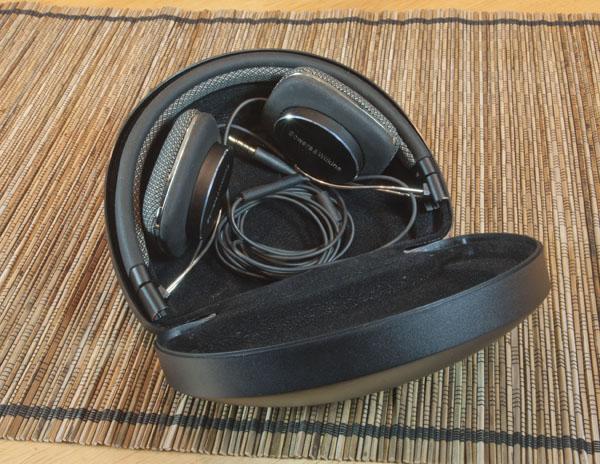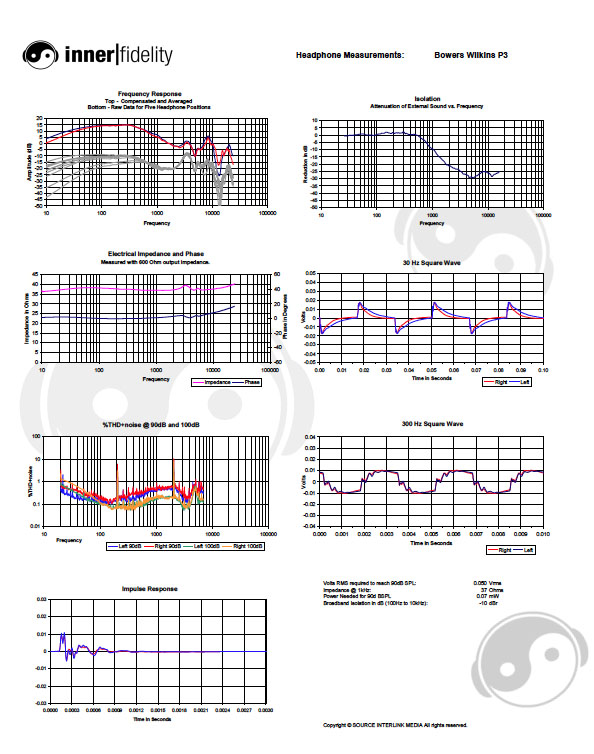| Columns Retired Columns & Blogs |
Bowers & Wilkins P3 Portable Headphone/Headset Page 2

Sound Quality
It might just be random chance, but there seems to be a growing trend among headphone makers today to roll off the treble a bit, in addition to boosting the bass. To some extent I think these are legitimate alterations. In my review of the B&W P5, I came to the conclusion that headphones intended primarily for phone and tablet duties benefit from a warm tilt. Movies are a little more fun with some oomph in the bass, and phone calls, YouTube videos, and streaming audio can be a bit screwed up in the highs, so a laid-back treble can make for a more pleasant listening experience. I continue to enjoy the warm, laid-back sound of the P5 for portable applications.
With the P3, however, B&W has simply gone too far with these adjustments. I found them remarkably muffled sounding. At first, I thought the treble had just gone missing, but on continued listening I came to the conclusion that the mid-range and upper-bass is simply too loud. Fundamental notes are very forward and the overtones are lost as a result, making these headphones sound very closed in.
B&W seems to work pretty hard on the acoustics of their products, and they claim to have gone to significant efforts to design a good driver for the P3. From their website:
P3's drive units have been designed from the ground up to give the best possible sound from a small set of headphones. We've repositioned the terminals to make sure that airflow around the drive units is uniform, resulting in a more linear movement. And we've introduced a unique damping system that provides the optimum balance of stiffness and flexibility.
I scratched my head for a while, then I simply removed the pads and had a listen. I had to push in on my ears a bit to get enough seal to reinforce the bass, but, holy smokes, they sound really good without the pads! The little indexing pins hurt so you couldn't possibly use them like this, but I firmly believe B&W did do a very nice job on the driver...and then messed it up with the pads. I decided to delve a little deeper and I cut away the material that covers the pads to see if that would solve the problem, but only got a minor improvement. My guess is that the foam of the cushion is simply absorbing far too much high frequency information.
So close, and yet so far away.
Click on graphs image to download .pdf for closer inspection.
Raw frequency response measurements show significant variation in low frequency response with position changes. Compensated and averaged frequency response shows a headphone with a very strong "n" shaped response centered just above the transition between bass and mid-range at about 200-300Hz. This hump is over 15dB higher in level than the treble range response of these cans, and was clearly heard as an over accentuated mid-range during listening tests. I have to say I'm surprised the treble response is as high as it is given how lackluster they sound.
30Hz square wave shows a fairly tight bass response given the on-ear design of these headphones. The THD+noise measurements also show lower distortion in the bass than many headphones of this type. Though they do take a bit of fiddling to get the headphones properly positioned, I did hear the bass as fairly tight and clean.
The lack of transient responsiveness is clearly evident in the 300Hz square wave. While I was surprised to see the treble response as strong as it was in the frequency response measurements, I'm not at all surprised with the near complete lack of clean edges in the 300Hz square wave. This is a poor result, and seems quite characteristic of what I heard.
The isolation of the P3 was modest at 10dB broadband. With a fairly constant 37 Ohm impedance and 50mVrms needed to achieve 90dB SPL, the P3 will easily be driven to solid listening levels by portable players.
Summary
Man, I really want to love these little headphones. The B&W P3 is truly a beautifully designed piece of gear, and I would have heartily recommended it if only they didn't have a fatal flaw in the way they sound. With a very strong emphasis on the lower-mids and upper-bass, the fundamental tones simply overpower the overtones that gives sound its character, which resulted in a muffled and closed-in sound in this case.
In the $199 price range I'd recommend the V-Moda M-80 as an alternative, and if you're willing to jump up to $299 I'll gladly recommend the big brother to these headphones, the B&W P5--one of my favorite headphones.
Resources
Bowers & Wilkins P3 product page.
Steve Guttenberg's comparison of the P3, P5, and M-80.
Very few impressions on Head-Fi so far, but when they come they'll be in the threads here, here, and here.
- Log in or register to post comments





































